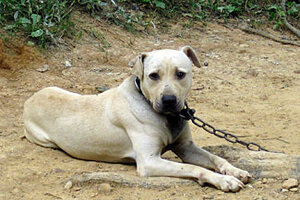Supreme Court questions animal cruelty law
Are dog-fighting videos free speech? Supreme Court justices Tuesday heard a case challenging a federal law covering depictions of animal cruelty.

This Aug. 11 photo released by Indiana's Monroe County Humane Association Authorities shows one of more than 100 pit bulls seized during raids of sites suspected of breeding and training dogs for illegal fighting.
Sarah Hayes, Monroe County Humane Association/AP
Washington
A US Supreme Court debate over the constitutionality of an animal cruelty law expanded Tuesday into an examination of whether Congress could ban pay-per-view broadcasts of human sacrifices.
In a lively and often amusing exchange, the justices took turns hurling ever-more-provocative hypothetical examples at counsel for both sides in a case that could produce a major holding in First Amendment free speech law.
Justice Antonin Scalia seemed to take personal umbrage at the broader implications of the law. An avid hunter, he came to the hearing armed with a long list of potential problems.
At one point, he suggested that aficionados of cock fighting, dog fighting, and bull fighting have a right to produce and distribute videotapes of the bloody battles "to present their side of the debate" over the value of such fights.
That prompted Justice Samuel Alito to ask: "What if people like to see human sacrifice … live pay-per-view over the Human Sacrifice Channel? Don't they have a right?"
In general, the justices seemed skeptical of the statute, with only Chief Justice John Roberts and Justice Alito raising questions consistently supportive of the government's defense of the cruelty law.
At issue in US v. Stevens is a challenge to a 1999 federal law that criminalizes the possession and distribution of depictions of animal cruelty. The law was aimed at drying up an underground market in so-called "crush videos," in which women in high heels step on and kill small animals. But the law was written more broadly to include a wider swath of animal cruelty.
Robert Stevens, an author and documentary producer, was convicted and sentenced to three years in prison because three of his videos included footage of pit bulls engaged in organized fights or bloody boar-hunting expeditions.
His lawyer, Patricia Millett, argued that the statute was too broad and criminalized more conduct that necessary. She urged the justices to invalidate the entire law as a violation of the First Amendment.
Defending the statute, Deputy Solicitor General Neal Katyal said that in the case of crush videos, the cruelty to the animal was a direct result of the production of the video. Congress followed the same approach when outlawing distribution and possession of child pornography. The child victims were being abused, in part, to produce the films.
While the justices agreed with Katyal in relation to crush videos, several expressed concern about what they viewed as vague language in the statute potentially criminalizing a wide range of unidentified conduct.
What about Spanish bullfight videos, Justice Scalia asked. Would they be a violation of the statute? How about someone hunting with a bow and arrow outside hunting season, Justice John Paul Stevens asked. Justice Stephen Breyer even mentioned "whale hunting."
Katyal said that dog fighting and cock fighting are outlawed in all 50 states and that images from such fights would violate the statute. But, he added, in the 10 years the law has been on the books prosecutors have not charged anyone for possessing depictions of bullfighting.
"This statute has nothing to do with the offensiveness of the message," he said. "It has to do with trying to dry up a market in animal cruelty."
Stevens' lawyer, Ms. Millett, said the statute was so vague it would frustrate judicial attempts at precise statutory interpretation and force judges instead to engage in "alchemy."
"People have a right to know how to conform their conduct to the law," she said.
-----
Click here for more background on the animal cruelty law case.
-----
Follow us on Twitter.
